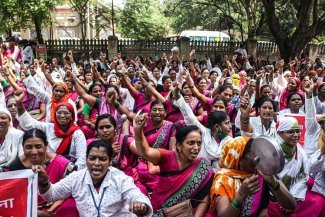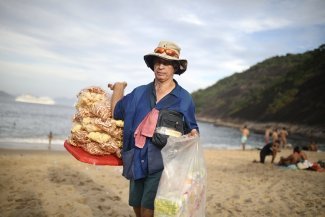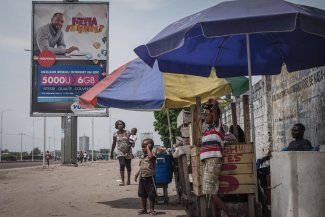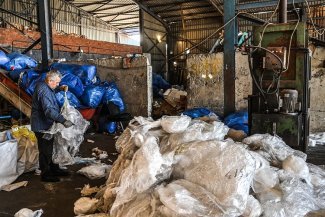Basame Lonje (looking straight at the camera) from Cameroon is amongst a throng of people waiting to be seen by immigration authorities in Tapachula, Mexico on 8 November 2019.
By the time Basame Lonje made it out of the jungle, he was beyond exhausted. The 35-year-old from Cameroon had gone four days out of seven without food, surviving each day on a single biscuit. He drank from rivers flowing with debris and death, carrying the corpses of an unknown number of people who have perished in the Darién Gap, a remote stretch of jungle between Colombia and Panama known as the most dangerous in the world. “I barely survived,” Basame says. “People had sores on the soles of their feet and they had nobody to carry them. They were left there. Do you know what it means to walk for days?”
As a result of tough migration policies in traditional destination countries in Europe, Basame is one of thousands of so-called ‘extracontinental migrants’ taking the desperate decision to try and traverse the American continent in the hope of seeking asylum in the United States or Canada. In previous times this route was used almost exclusively by central American migrants. More recently it has seen a surge in migrants from African countries like Cameroon, the Democratic Republic of Congo (DRC), Eritrea, Mauritania, Nigeria, Ghana and Burkina Faso, as well as people from Asian and Middle Eastern countries such as India, Pakistan, Syria and Nepal. Mexico authorities apprehended around 3,000 Africans and some 12,000 extracontinental migrants in total in 2018, according to the Migrant Policy Unit of Mexico’s Interior Ministry. Most are escaping a mix of conflict, political repression and crumbling economies.
They fly to visa-friendly countries such as Ecuador, Brazil and Guyana, before navigating their way up north to Mexico, sometimes with the help of smugglers, other times with the aid of social media posts of those who have gone before them. They spend thousands of dollars on flights and bus tickets for journeys that can take months.
Basame was a teacher back in Cameroon but says he fled the bloody conflict that has been raging in parts of his country since 2016 after he was abducted by armed groups fighting for the secession of the English-speaking parts of the country. His crime? Daring to hold classes.
Basame arrived in Mexico five months ago, but like thousands of others, he is trapped in Tapachula, a city on the border with Guatemala in the southern Mexican state of Chiapas. These migrants and refugees are caught in the net of new US immigration regulations designed to stop irregular migration, a key feature of President Donald Trump’s administration.
New migration regulations have rolled out swiftly and unpredictably since Trump took office in January 2017. Military troops were deployed to the border in October 2018, when some 7,000 people from central America fleeing gang violence and poverty approached on foot. In January 2019, the Migration Protection Protocols (MPP), known as ‘Remain in Mexico’ went into effect: as a result, asylees that arrive in the US via Mexico are now sent back to wait while their cases are processed, instead of being released on parole in the US as prescribed by US law. Rights organisations point out that sending asylum seekers back to Mexico, where they often face deportation, is a violation of the 1951 Refugee Convention.
This February, Trump declared a state of emergency and accessed emergency funds to begin construction of a physical wall between the US and Mexico. He has also pursued agreements with El Salvador, Guatemala and Honduras under which all migrants who pass through these countries must first seek refuge and be rejected in them before placing claims in the US. The agreement disregards the fact that not only do these countries lack the capacity to process large-scale asylum claims but that many people are fleeing violence and poverty from these same countries.
Cumulatively, these policies have seen thousands of people waiting in shelters in US-Mexico border towns like Tijuana and Matamoros where conditions are deteriorating. A ‘metering’ system sees US customs officials attend to about three people daily. Mexico’s northern towns are also notorious for violence, and migrants are vulnerable to exploitation by drug cartels and human traffickers.
Externalising borders
In July 2019, Mexico signed an agreement with the US after President Trump threatened to impose trade sanctions if migration flows were not brought to a minimum. President Andrés Manuel López Obrador agreed to deploy 6,000 troops from the newly-formed National Guard to police its borders, adopting the US border militarisation strategy and sealing Mexico’s fate as President Trump’s outer wall.
Since then, Mexican immigration officials have stopped issuing exit permits to extracontinental migrants arriving at the southern border, trapping many like Basame in a country they have no desire to stay in. With fewer people able to reach the US, Mexico – a transit country – is becoming an unintentional final destination. Although Mexico has refused to sign a third safe country agreement with the US, it has been forced to field over 60,000 asylum claims – double the number received last year. It has been estimated that 60 per cent of these applications are made in Tapachula.
One Tuesday last month, Basame arrived at the immigration office in Tapachula hours before his appointment to beat the crowds. He is desperate to reach the US. “I’ve been through so much,” Basame says. “I need somewhere that I feel safe and can build a new life.”
With no work permit, and even if he had one, with few opportunities available to him as an African migrant and a non-Spanish speaker, Basame is clear about his options: “Mexico can’t give me that.”
But Mexico’s immigration agency has denied his application for a visitor’s visa that would help him move north. Officials are only issuing permanent residency cards, a document that he fears will affect his asylum claim in the US.
By 09.00, hundreds of men and women from over two dozen countries were waiting in the blistering sun. Their voices were a cacophony of languages – Spanish, English, Portuguese, French, Tigrinya and Haitian Creole – clashing with the wails of hot, hungry children hanging from their parents. Migrants of Asian origin are mostly absent from these daily crowds: since Mexico deported 310 Indian migrants in an “unprecedented” move this October, they have been keeping a low profile for fear of suffering a similar fate.
An immigration officer appeared behind the gate, looked at the crowd and shook his head in frustration. A fight broke out when the gates opened as people rushed to get in. Despite his punctuality, Basame was not seen that day.
“My friends died there”
Narrating his long, treacherous journey from Cameroon to Mexico, Basame tells Equal Times that after fleeing the captivity of armed rebels this March, he headed to Nigeria before deciding to try to reach the safety of the US. He wanted better opportunities than Nigeria could offer and feared the rebels could easily reach him there. First, he took a flight to Ecuador, then by bus he moved through Colombia. In the north-western town of Capurgana on the Colombian-Panamanian border, he met fellow Cameroonian migrants, as well as Haitians and Cubans. As they prepared to enter the Darién, villagers living at the mouth of the jungle warned them: “If you start this journey, you must finish it, otherwise it is bad news,” alluding to the dangers of the wild animals, poisonous insects and armed kidnappers marauding inside the impenetrable rainforest that breaks up the Pan-American Highway.
Basame spent seven days in the dense thickness of the Darién, battling the rain and cold, moving from morning until nightfall with nothing but a bag of clothes and some snacks. “You do not stop in the Darién. You keep moving,” he says. He walked with a group of other migrants. Many didn’t make it out of the jungle due to exhaustion. Others were swept away in the fast-moving rivers. “My friends died there,” Basame remembers soberly. One of his worst memories is of walking past the corpse of a dead baby left in a backpack.
There is no data on how many people have died in the Darién, but 104 migrant deaths have been recorded in central America this year, according to the International Organization of Migration (IOM).
Basame is one of the lucky ones. After reaching Panama, exhausted and starving, he regained his strength before moving up through Costa Rica, Nicaragua, Honduras and Guatemala. After crossing the Suchiate River into Mexico by raft, he arrived in Tapachula in July. He spent a week at an immigration detention centre there before he was given an exit permit to leave the country.
It wasn’t until he got pulled from a bus to Tijuana by the National Guard that he realised that he could not legally leave Tapachula unless he was heading south, back to Guatemala. The US-Mexico deal took effect on 10 July and he was amongst the first people stranded by Mexico’s new regulations. Basame’s permit would force him back through the jungle of death he had barely survived.
Death and disease in Mexico
Judeline Romelus sits with her friends in Tapachula’s main square watching as they braid the hair of her 10-year-old daughter, Mariska. Nearby, Ghanaian and Guinean flags announce African food at restaurants, alongside Mexican and Honduran colours. Haitians and Africans give locals a trim in makeshift barbershops.
But the general atmosphere of warmth masks the apprehension many locals feel. Despite being in one of the country’s poorest regions, Tapachula has tried to bear the weight of its new migrant population but some people are concerned that government agencies and NGOs are focusing their attention on these new arrivals when the needs of the locals are also many.
Like Basame, Judeline and Mariska are stranded. Judeline applied for a humanitarian visa so that she can travel north with her daughter, but she must wait for her appointment in February 2020. The 28-year-old mother packed her bags and left Haiti three months ago. Economic stagnation and recent political unrest have caused many to flee the small Caribbean nation. “There are no opportunities in Haiti and I cannot work,” she says, even with a diploma. Judeline says she is looking for a better life in the US where friends are waiting for them in Florida. She relies on their monthly remittances of US$50 to pay for the small room the mother and daughter share.
Judeline is one of the few lucky ones. Until very recently, at the immigration detention centre, dozens of people, mainly from DRC and Angola, camped in tents while waiting for officials to grant them passage north. With no money they could not pay to rent a home or buy food.
The unsanitary living conditions in overcrowded shelters such as these have caused a spike in health problems. “Women are presenting diseases related to sexual and reproductive health,” says Claudia León, regional head at Jesuits Refugee Service, a humanitarian non-profit providing legal and psychosocial assistance to refugees. Many were assaulted in the Darién. “The situation is critical. They have no clean water to wash with and those who are pregnant are at risk.”
Migrants of all nationalities are suffering from invisible illnesses too. A spokesperson for the medical humanitarian NGO Médecins Sans Frontières (MSF) says it is dealing with many cases of post-traumatic stress disorder, anxiety and trauma. Poor living conditions coupled with the memories of the treacherous journey to Mexico and the general uncertainty is causing some to self-harm. “We are in an emergency,” says León. “I have seen people outside the immigration centre hurting themselves because they are in such extreme conditions.”
The desperation to get to the US has led to the exploration of dangerous alternative routes. A boat smuggling Cameroonian migrants capsized off the coast of Mexico in October, killing one man. “We knew him,” one migrant tells Equal Times at the restaurant where the deceased once frequented. But even as they recall his tragic passing, another man says that he is also considering taking the same route to the US.
“The new Mediterranean”
All across the world, tough policies on migration are forcing the most vulnerable migrants and refugees to go underground and seek the services of smuggling gangs and human traffickers. Like the US, Europe has enforced stringent measures to stem migration flows. An increase in anti-immigrant sentiments from far-right, populist governments in the US and Europe in particular sees leaders like Trump and Hungary’s Viktor Orban routinely employ rhetoric that fuels racist anxieties and emphasises the building of walls to prevent a ‘migrant invasion’.
In 2016, Turkey signed an agreement with the European Union and a bilateral agreement with Greece to keep some three million refugees fleeing the Syrian war from crossing the Aegean Sea into Greece. The agreement saw the European Union send back anyone who crossed without documents after 20 March 2016.
A similar agreement between Italy and Libya in 2017 was extended this November. Italy is training and funding the Libyan Coast Guard to stop African and Middle Eastern migrants on the Mediterranean and return them to Libya, a country at war.
Interception numbers have dropped from 181,000 in 2016 to only 8,000 this year, according to UNHCR. Thousands are held in detention centres run by armed factions battling for control since the Arab uprisings of 2011. African migrants have been enslaved, tortured and sold. They have also been caught in the crossfire of the battle for Tripoli. In July, a bomb fell on one detention centre, killing 44 people.
The dramatic decrease in Mediterranean crossings corresponds sharply with increased flows from Africa to south America. Deaths at sea are being replaced by deaths in the Darién. “It is the new Mediterranean,” León says.
The number of asylum claims in Mexico keeps rising and is expected reach 80,000 by the end of the year. Although most Africans initially refused to seek asylum in Mexico, more people are applying, particularly from Cameroon. The number of asylum claims from Africa is currently around 500.
The influx of migrants and refugees has split Mexico politically, with many accusing President Obrador of yielding to President Trump and rescinding on human rights promises he made when he campaigned last year.
Human rights organisations condemn the US and Mexico’s strategies. “Those seeking safety want the same thing any of us would want if we were in their shoes,” says Isa Sanusi, of Amnesty International in Nigeria. “Mexico and the US must ensure that these migrants from Africa and other parts of the world are not denied the rights guaranteed to them by international law.”
For now, Basame is stuck between a rock and a hard place. Even if he had the money, it would be too dangerous for him to go home, and yet he currently has no way out of Mexico. As he struggles to stay afloat, his hopes are fading fast. “I’m running out of cash and I’m running out of patience. I’m sick and I don’t have anywhere to live,” he says. “How will I survive?”










